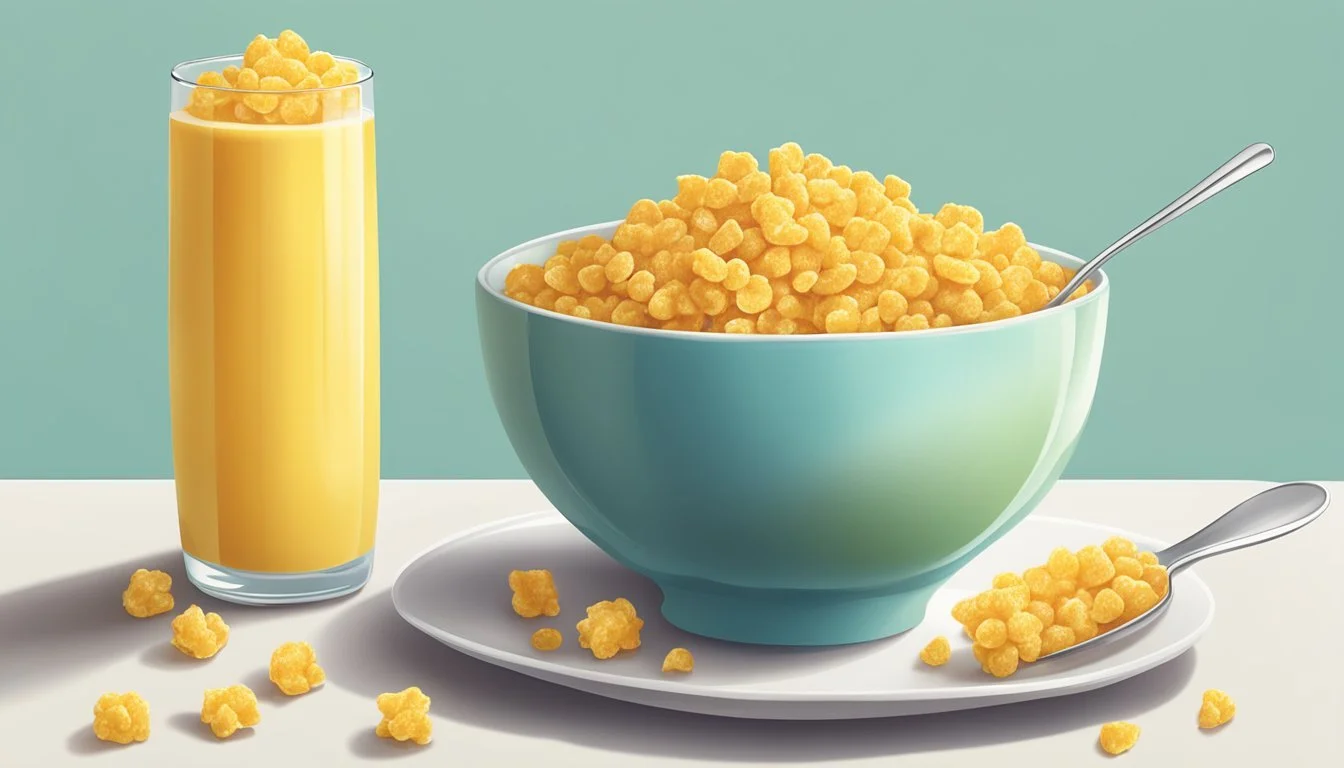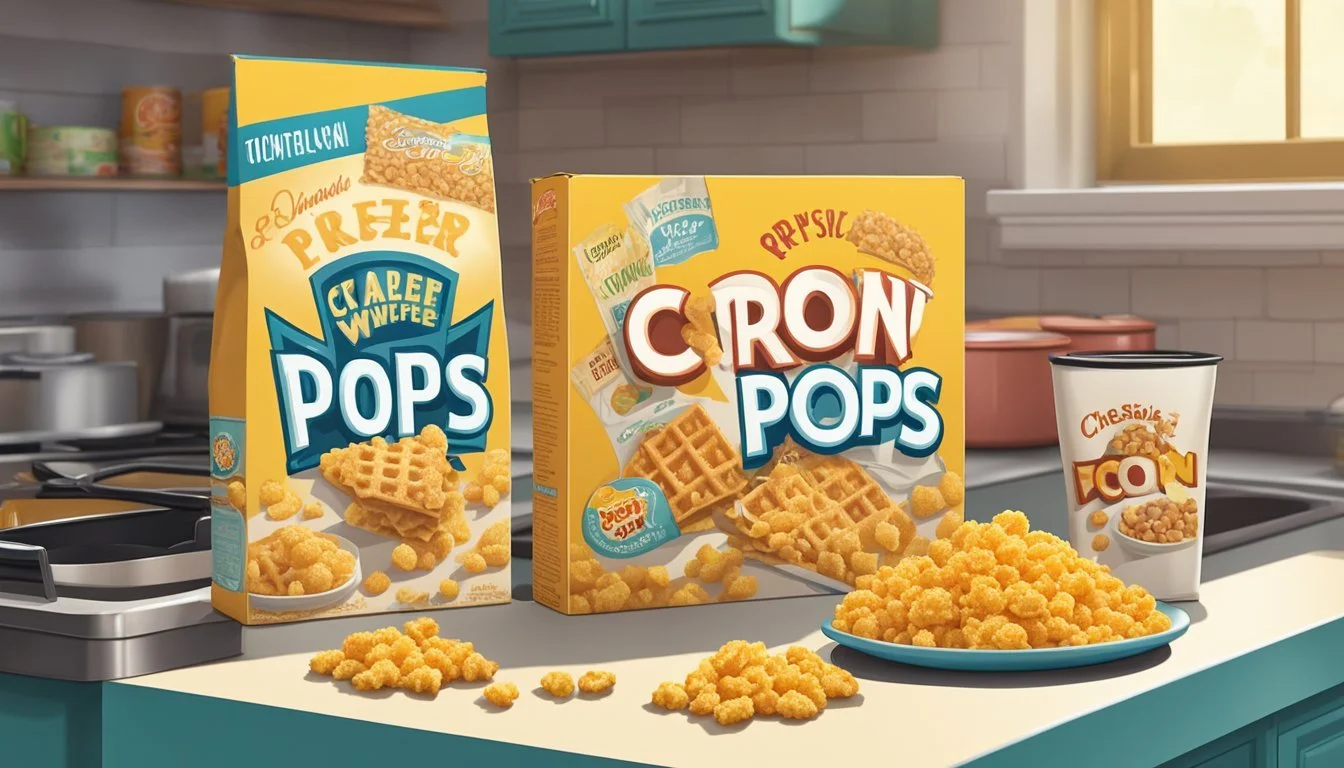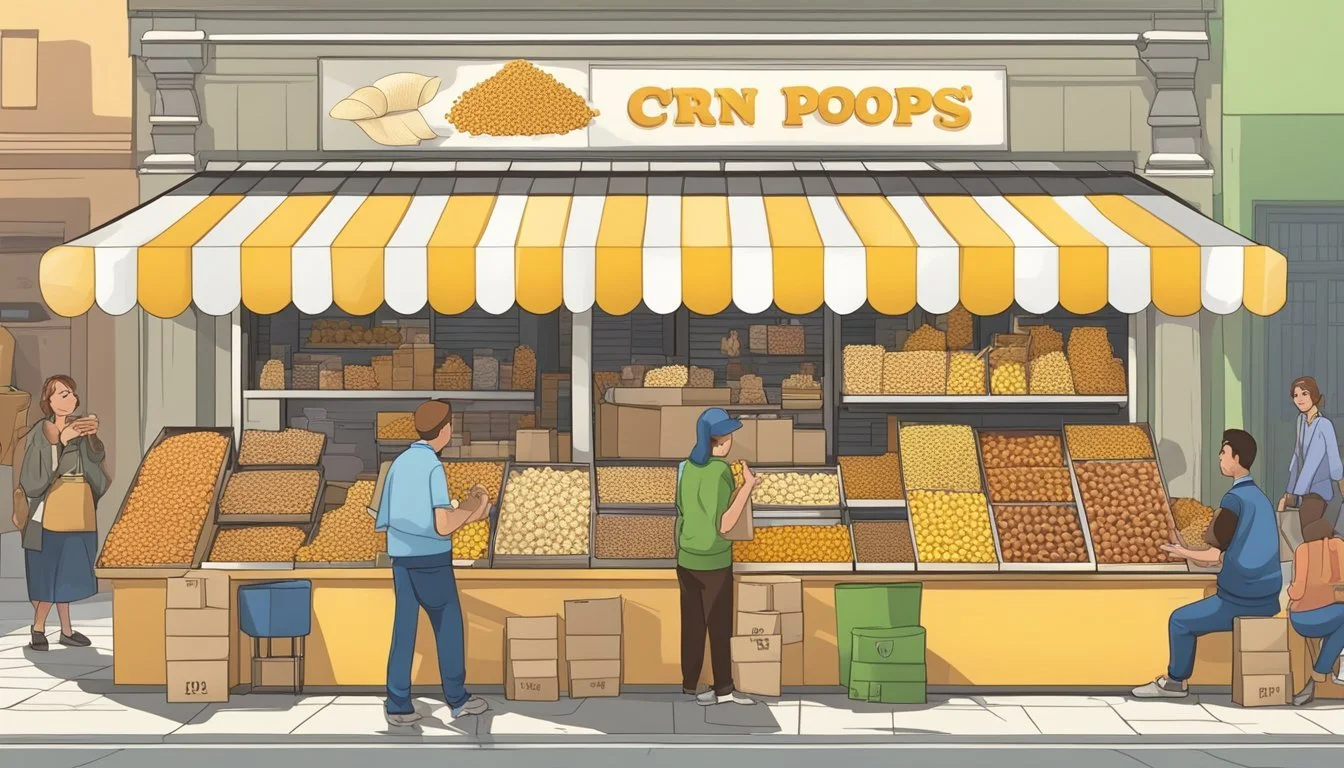Corn Pops vs Waffle Crisp
Breakfast Cereal Showdown
This Article is Part of Our Breakfast Cereal Guide with Details on Corn Pops Nutrition and Waffle Crisp Nutrition
In the world of breakfast cereals, the debate between Kellogg's Corn Pops and Post's Waffle Crisp can often spark curiosity. Corn Pops offer a slightly crunchy bite with a sweet flavor, making them a staple for many breakfast tables over the years. Waffle Crisp, on the other hand, aims to mimic the beloved taste of waffles drenched in syrup, providing a unique twist to the cereal experience.
When comparing nutritional values, Corn Pops lead with a lower sugar content, which may appeal to the health-conscious. Waffle Crisp, however, delivers a more indulgent flavor profile that some might find irresistible. Choosing between Corn Pops and Waffle Crisp ultimately comes down to personal preference and dietary priorities.
By examining taste, texture, and nutrition, this blog post delves into what sets these two breakfast favorites apart. Dive in to discover which cereal best fits your morning routine.
Historical Background
Corn Pops and Waffle Crisp, two popular breakfast cereals, offer distinct flavors and histories. Each has left a unique mark on the breakfast table over the years.
Origins of Corn Pops
Corn Pops were introduced by Kellogg’s in 1950. Initially named "Corn Pops," they underwent several name changes, including "Sugar Corn Pops" in 1951. The cereal became a sponsor for radio and TV shows like "The Adventures of Wild Bill Hickok." Known for its puffed grain and sweet taste, Corn Pops quickly gained popularity.
The branding reverted to "Corn Pops" later. The cereal is characterized by its crunchy texture and sweet flavor, appealing to children and adults alike. Kellogg’s continually marketed Corn Pops effectively, embedding the cereal into popular culture.
Introduction of Waffle Crisp
Waffle Crisp was launched by Post in 1996. The cereal featured mini waffle-shaped, maple syrup-flavored corn pieces, making it stand out among breakfast options. Early commercials highlighted its unique shape and syrupy taste, quickly capturing consumer interest.
In 2013, Post introduced a budget-friendly version called "Waffle Crunch" as part of the Good MOREnings line. Despite its popularity, Waffle Crisp was discontinued in 2018. The cereal remains a nostalgic favorite for many people who enjoyed it during its production years.
Nutritional Comparison
When comparing Corn Pops and Waffle Crisp cereals, it is important to understand their differences in macronutrients, vitamin and mineral content, as well as sugar and fiber content. Each cereal offers distinct nutritional benefits and considerations.
Macronutrient Breakdown
Corn Pops
Calories: 150 per 1 1/3 cup serving
Total Fat: 0g
Cholesterol: 0mg
Sodium: 160mg
Total Carbohydrates: 36g
Protein: 2g
Waffle Crisp
Calories: 120 per 1 cup serving
Total Fat: 2g
Cholesterol: 0mg
Sodium: 220mg
Total Carbohydrates: 34g
Protein: 2g
Corn Pops have slightly higher calories and carbs per serving compared to Waffle Crisp. Waffle Crisp contains more fat and sodium, which may be a consideration for those monitoring their fat or salt intake.
Vitamin and Mineral Content
Corn Pops and Waffle Crisp provide different vitamins and minerals essential for health.
Corn Pops
Rich in Calcium and Iron
Often fortified with Vitamin D and Vitamin C
Waffle Crisp
Higher in several B vitamins including Vitamin B12, B6, B1, B2, and Folate
Contains more Iron
Also provides Vitamin A RAE and Zinc
Waffle Crisp stands out with its B-vitamin content, which is crucial for energy metabolism. Corn Pops are more fortified with Vitamin D and C, beneficial for bone health and immune function, respectively.
Sugar and Fiber Content
Corn Pops
Sugar: 15g per serving
Dietary Fiber: 0g
Waffle Crisp
Sugar: Not explicitly listed
Dietary Fiber: 1g per serving
Corn Pops contain 15g of sugar per serving, which is relatively high and a consideration for those limiting sugar intake. Waffle Crisp provides some dietary fiber, which aids in digestion, although quantities of sugar in Waffle Crisp were not specified.
In conclusion, both cereals offer unique nutritional profiles. Corn Pops are lower in fat and provide certain vitamins, whereas Waffle Crisp has higher B vitamin content and slightly better fiber intake. Personal dietary needs should guide the choice between these two cereals.
Taste and Texture
Corn Pops and Waffle Crisp offer distinct taste and texture experiences. Where Corn Pops highlight a sweet, honey-nut flavor with a signature crunch, Waffle Crisp emphasizes a rich, maple-flavored profile with a crisp texture.
Corn Pops' Signature Crunch
Corn Pops are known for their unique texture—a light, airy crunch that is satisfying to bite into. The extruded corn puff shape provides a consistent mouthfeel, yielding to a slightly chewy center. The sweetness comes from a honey-nut glaze, giving each piece a pleasant, mild flavor that balances the corn base without being overpowering.
The crunchiness remains even after brief exposure to milk, making it a favorite for those who enjoy a consistent texture throughout their meal. This crunchy texture is a key characteristic that defines Corn Pops and sets them apart from softer cereals.
Waffle Crisp's Flavor Profile
Waffle Crisp offers a contrasting sensory experience with its emphasis on maple flavoring. The cereal pieces are shaped to mimic tiny waffles, providing a visual cue to their taste. Each piece has a robust, sweet maple flavor that penetrates deeply, resembling the taste of classic breakfast waffles.
The texture of Waffle Crisp is notably crispy, maintaining its form even when submerged in milk. This crispy texture complements the strong maple flavor, creating a delightful combination that appeals to those who enjoy a flavorful, crunchy bite.
Market and Pricing
Corn Pops and Waffle Crisp are popular breakfast cereals with distinct price points and availability factors influencing consumer choices.
Price Comparison
Corn Pops are generally priced around $3-$4 per 10-ounce box. Factors such as brand reputation and ingredient costs can influence this price. Corn Pops typically offer good value for money, especially when considering promotions and discounts.
Waffle Crisp, on the other hand, often retails at a slightly higher price point, around $4-$5 for a similar-sized box. This could be attributed to its unique flavor profile and nostalgia factor. Brand loyalty and seasonal price fluctuations also impact pricing.
Availability and Purchase Options
Corn Pops are widely available in major grocery chains, discount stores, and online platforms. Its high production volume ensures steady stock. Consumers can purchase Corn Pops in various packaging options, including family-sized boxes and promotional packs.
Waffle Crisp experienced a disruption in availability due to its temporary discontinuation from 2018 to 2021. However, since its reintroduction, it has become more accessible in major retail stores and online marketplaces. The cereal is now packaged in boxes instead of bags, catering to convenience and consumer preferences.
Health Impact
Considering the nutritional aspects of Corn Pops and Waffle Crisp cereals, differences in satiety, weight management, and blood sugar levels mostly depend on their carbohydrate content and Glycemic Index.
Satiety and Weight Management
Corn Pops and Waffle Crisp have different impact on satiety and weight management. Corn Pops tend to have higher sugar content. Waffle Crisp provides around 2g of fat and 1g of fiber per serving. Fiber and fats generally slow digestion, potentially increasing feelings of fullness.
Net Carbs for Waffle Crisp stand at approximately 33g per serving, versus Corn Pops with slightly different values. High net carbs can influence weight management, making it harder. Corn Pops are usually low in fiber, which can lead to quicker digestion and less satiety.
Effect on Blood Sugar Levels
The Glycemic Index (GI) measures how fast carbohydrate-containing food raises blood sugar levels. Both cereals likely have high GI due to their sugar content and low fiber levels. Waffle Crisp has 12% of the daily value (DV) for total carbs per serving, while Corn Pops vary.
Foods with high GI can result in rapid spikes in blood sugar levels. This can be concerning for those managing diabetes or insulin sensitivity. Both cereals offer similar nutrient profiles, with Corn Pops not providing significant fiber to modulate the GI.
Cereal Alternatives
When comparing Kellogg's Corn Pops and Post's Waffle Crisp, it’s essential to explore other cereals that offer similar tastes or nutritional profiles and consider diverse breakfast choices that could serve as healthier or equally fulfilling options.
Similar Products in the Category
Lucky Charms offers sweet, marshmallow-filled enjoyment comparable to Corn Pops and Waffle Crisp but with a unique texture due to the combination of crunchy cereal and soft marshmallows.
Cocoa Puffs and Reese's Puffs cater to chocolate lovers while providing a similar crunch factor.
Honeycomb and Golden Grahams are good alternatives for those who prefer honey-flavored cereals with a crunchy texture.
Trix and Froot Loops introduce a burst of fruity flavor, ideal for those wanting a more diverse taste profile.
Cereal Key Features Lucky Charms Sweet, includes marshmallows Cocoa Puffs Chocolate flavor, crunchy texture Honeycomb Honey flavor, large pieces Trix Fruity flavors, vibrant colors
Comparing Other Breakfast Options
Toast with avocado, for instance, provides healthy fats and proteins that cereals like Corn Pops and Waffle Crisp lack.
Smoothies made with fruits, vegetables, and protein powder can offer a balanced, nutrient-dense start to the day.
Greek yogurt with granola or mixed nuts can serve as an excellent blend of protein, fiber, and healthy fats.
Traditional breakfasts like oatmeal or scrambled eggs are nutritious alternatives, consistently recommended for their balance of macronutrients and satiety.
For those seeking convenience, protein bars and overnight oats can replicate the ease of ready-to-eat cereals while enhancing nutritional intake.
Breakfast Option Benefits Avocado toast Healthy fats, protein Smoothies Nutrient-dense, customizable Greek yogurt with nuts High in protein, fiber Oatmeal Fiber-rich, versatile Protein bars Convenient, protein-packed
Environmental and Ethical Considerations
Corn Pops and Waffle Crisp cereals differ significantly in their production processes and packaging efforts, impacting their environmental footprint and ethical standing.
Production Processes
Corn Pops, produced by Kellogg's, and Waffle Crisp, under Post Consumer Brands, have distinct production processes. Corn Pops uses corn as its primary ingredient, which typically involves intensive farming practices requiring significant water and pesticide use. These farming methods can lead to soil degradation and water contamination.
In contrast, Waffle Crisp incorporates a range of ingredients including enriched flour and grains which could have varying impacts based on sourcing practices. Ethical considerations include labor practices in crop cultivation, particularly concerning child and forced labor in certain regions. Both brands emphasize quality control, but the environmental cost of ingredient sourcing remains a concern.
Packaging and Sustainability Efforts
Packaging plays a crucial role in the environmental footprint of cereal brands. Both Corn Pops and Waffle Crisp have traditionally relied on plastic and cardboard packaging. This type of packaging adds to landfill waste and has a slow decomposition rate.
Recently, Post Consumer Brands reintroduced Waffle Crisp in boxes rather than bags, which may enhance recyclability. Meanwhile, Kellogg's has committed to using 100% reusable, recyclable, or compostable packaging by the end of 2025. This initiative aims to reduce plastic waste and promote sustainability.
Companies must also consider the carbon footprint of their logistics networks. Transportation of ingredients and finished products contributes to greenhouse gas emissions, highlighting the need for greener alternatives in distribution.
Consumer Perspectives
Consumer feedback highlights both nostalgia and brand loyalty, while reviews and preferences provide insights into the popularity and taste preferences for Corn Pops and Waffle Crisp cereals.
Brand Loyalty and Nostalgia
Consumers have strong emotional attachments to both Corn Pops and Waffle Crisp. Kellogg's Corn Pops has been on the market for decades, entrenching itself in the memories of many adults who ate it as children. Post's Waffle Crisp, though discontinued for a few years, made a triumphant return in 2022 due to consumer demand.
Waffle Crisp enthusiasts often cite childhood memories as their primary reason for purchasing. The flavor and unique waffle shape evoke nostalgia, generating significant loyalty among those who grew up eating it. Similarly, Corn Pops enjoys loyalty for its sweet corn taste and crunchy texture, familiar to many as part of their morning routine.
Consumer Reviews and Preferences
Reviews indicate a mixed reception for both cereals in terms of health and taste. Corn Pops often receive criticism for their high sugar content and lack of fiber but remain popular due to their sweet flavor and crunch. On the other hand, Waffle Crisp is praised for its maple syrup flavor and distinctive waffle-like shape.
In terms of market trends, Waffle Crisp benefited from consumer petitions and social media campaigns calling for its return. Corn Pops maintains a steady market presence, appealing to both new consumers and long-time fans. Preferences often depend on whether consumers prioritize nostalgic flavors or are looking for a specific taste experience.







